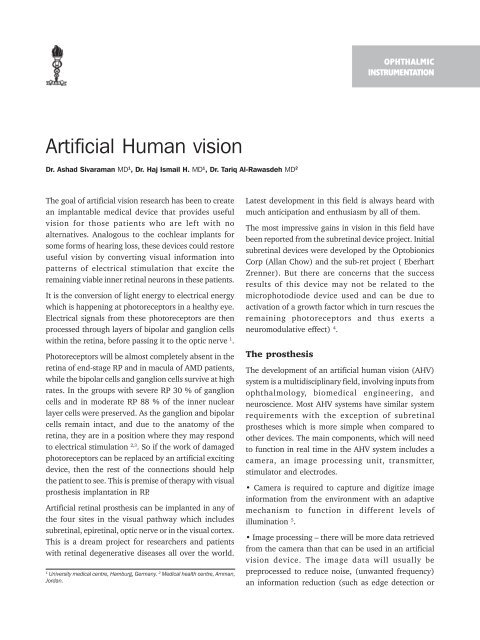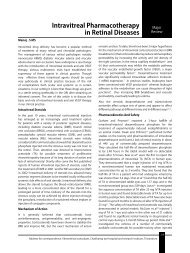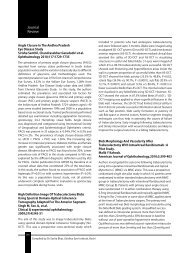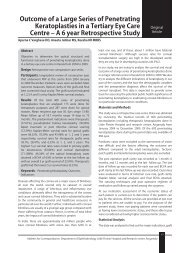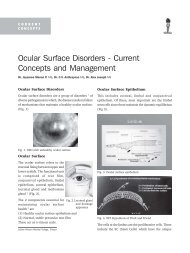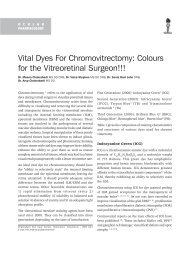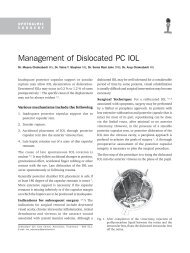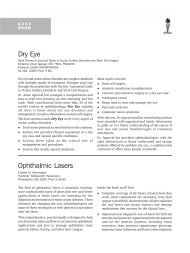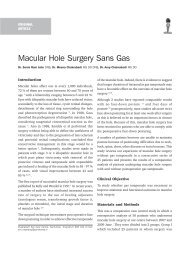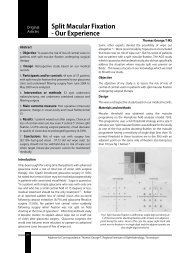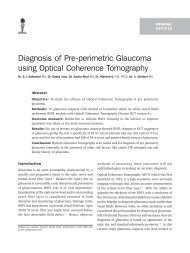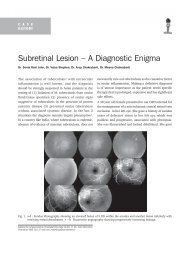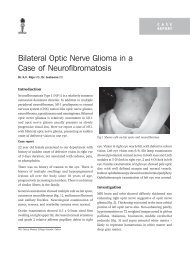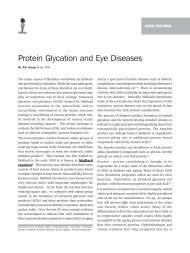Artificial Human vision - KSOS
Artificial Human vision - KSOS
Artificial Human vision - KSOS
You also want an ePaper? Increase the reach of your titles
YUMPU automatically turns print PDFs into web optimized ePapers that Google loves.
December 2009 Arshad Sivaraman et al. - <strong>Artificial</strong> <strong>Human</strong> Vision 421<br />
<strong>Artificial</strong> <strong>Human</strong> <strong>vision</strong><br />
Dr. Ashad Sivaraman MD 1 , Dr. Haj Ismail H. MD 1 , Dr. Tariq Al-Rawasdeh MD 2<br />
The goal of artificial <strong>vision</strong> research has been to create<br />
an implantable medical device that provides useful<br />
<strong>vision</strong> for those patients who are left with no<br />
alternatives. Analogous to the cochlear implants for<br />
some forms of hearing loss, these devices could restore<br />
useful <strong>vision</strong> by converting visual information into<br />
patterns of electrical stimulation that excite the<br />
remaining viable inner retinal neurons in these patients.<br />
It is the conversion of light energy to electrical energy<br />
which is happening at photoreceptors in a healthy eye.<br />
Electrical signals from these photoreceptors are then<br />
processed through layers of bipolar and ganglion cells<br />
within the retina, before passing it to the optic nerve 1 .<br />
Photoreceptors will be almost completely absent in the<br />
retina of end-stage RP and in macula of AMD patients,<br />
while the bipolar cells and ganglion cells survive at high<br />
rates. In the groups with severe RP 30 % of ganglion<br />
cells and in moderate RP 88 % of the inner nuclear<br />
layer cells were preserved. As the ganglion and bipolar<br />
cells remain intact, and due to the anatomy of the<br />
retina, they are in a position where they may respond<br />
to electrical stimulation 2,3 . So if the work of damaged<br />
photoreceptors can be replaced by an artificial exciting<br />
device, then the rest of the connections should help<br />
the patient to see. This is premise of therapy with visual<br />
prosthesis implantation in RP.<br />
<strong>Artificial</strong> retinal prosthesis can be implanted in any of<br />
the four sites in the visual pathway which includes<br />
subretinal, epiretinal, optic nerve or in the visual cortex.<br />
This is a dream project for researchers and patients<br />
with retinal degenerative diseases all over the world.<br />
1 2 University medical centre, Hamburg, Germany. Medical health centre, Amman,<br />
Jordan.<br />
Latest development in this field is always heard with<br />
much anticipation and enthusiasm by all of them.<br />
The most impressive gains in <strong>vision</strong> in this field have<br />
been reported from the subretinal device project. Initial<br />
subretinal devices were developed by the Optobionics<br />
Corp (Allan Chow) and the sub-ret project ( Eberhart<br />
Zrenner). But there are concerns that the success<br />
results of this device may not be related to the<br />
microphotodiode device used and can be due to<br />
activation of a growth factor which in turn rescues the<br />
remaining photoreceptors and thus exerts a<br />
neuromodulative effect) 4 .<br />
The prosthesis<br />
OPHTHALMIC<br />
INSTRUMENTATION<br />
The development of an artificial human <strong>vision</strong> (AHV)<br />
system is a multidisciplinary field, involving inputs from<br />
ophthalmology, biomedical engineering, and<br />
neuroscience. Most AHV systems have similar system<br />
requirements with the exception of subretinal<br />
prostheses which is more simple when compared to<br />
other devices. The main components, which will need<br />
to function in real time in the AHV system includes a<br />
camera, an image processing unit, transmitter,<br />
stimulator and electrodes.<br />
• Camera is required to capture and digitize image<br />
information from the environment with an adaptive<br />
mechanism to function in different levels of<br />
illumination 5 .<br />
• Image processing – there will be more data retrieved<br />
from the camera than that can be used in an artificial<br />
<strong>vision</strong> device. The image data will usually be<br />
preprocessed to reduce noise, (unwanted frequency)<br />
an information reduction (such as edge detection or
422 Kerala Journal of Ophthalmology Vol. XXI, No. 4<br />
segmentation) or a scene understanding approach,<br />
attempting to extract information that can be used.<br />
• Transmitter is the link from the camera/ image<br />
processing components to the stimulator and<br />
electrode array,( which are usually located inside<br />
the body). Percutaneous or transcutaneous<br />
connections can be used for this connection 6 . A<br />
transcutaneous connection uses radiofrequency<br />
telemetry to send data and power to the embedded<br />
stimulator where as percutaneous devices uses<br />
direct cables. The transcutaneous devices have the<br />
advantages of reduced risk of infection.<br />
Even though earlier devices were made for<br />
Percutaneous connections the new generation ones<br />
are transcutaneous. This is being used in the current<br />
trials of new generation intelligent medical implant<br />
systems and by other researchers.<br />
• Electrodes are thin wires, which allow a small<br />
amount of precisely controlled electrical current to<br />
pass through it to stimulate the neurons. There are<br />
two main types of electrodes discussed in the<br />
literature; surface electrodes, which lie flat against<br />
the stimulation target and penetrating electrodes,<br />
which are inserted inside the stimulation target.<br />
Stimulator, located outside the body receives<br />
information from the transmitter and send through<br />
multiple electrodes.<br />
Subretinal Prosthesis are different from all other forms<br />
of artificial <strong>vision</strong> devices in terms of location of<br />
implantation, its energy needs, proximity to the inner<br />
retinal layers, existence in the subretinal atmosphere,<br />
heat generation etc. the details of this will be described<br />
later in this article.<br />
Types of artificial <strong>vision</strong> devices<br />
Different methods of implants are tried in different parts<br />
of the visual pathway starting from retina, optic nerve<br />
and optic radiation.<br />
(a) Cortical prosthesis; (photograph)<br />
In 1929, Forester noticed that cortical stimulation with<br />
electrodes caused the subject to see a spot of light in a<br />
position that depended on the site of stimulation 7 . Later<br />
in sixties and early seventies Brindley and Lewin worked<br />
on this and implanted an array of 80 platinum<br />
electrodes in a 52-year-old legally blind. Stimulation<br />
of these electrodes produced discernible phosphenes<br />
and also found that phosphenes moved with eye<br />
movements and that phosphene perception usually (but<br />
not always) stopped when stimulation ceased 8 .<br />
Dobelle worked on this and came out with similar<br />
reports of stimulus perception. In late seventies he used<br />
a 64-channel platinum electrode surface stimulation<br />
prosthesis and showed that it can allow blind patients<br />
to recognize 6-inch characters at 5 feet (approximately<br />
20/1200 visual acuity) 7 . Patients in these initial<br />
experiments complained of an inability to appreciate<br />
distinct phosphenes, but rather reported seeing “halos”<br />
surrounding each of these phosphenes 9 . This approach<br />
has advantage of the potential to restore <strong>vision</strong> to the<br />
largest number of blind patients as it bypasses all<br />
diseased visual pathway neurons rostral to the primary<br />
visual cortex.But the disadvantages includes the<br />
difficulties encountered in controlling the number of<br />
phosphenes induced by each electrode, and interactions<br />
between phosphenes, need for high currents and large<br />
electrodes that can induce pain due to meningeal<br />
stimulation and occasional focal epileptic activity<br />
following electrical stimulation.<br />
There are two methods for cortical stimulation<br />
discussed. The one with surface stimulation electrodes<br />
and other with intra cortical electrodes. Intra cortical<br />
stimulation was introduced in the hope of remedying<br />
the shortcomings of surface cortical stimulation via a<br />
lower current and higher fidelity system. This employed<br />
smaller electrodes closer to the target neurons,<br />
therefore requiring less current and resulting in a more<br />
localized stimulation. Initial studies, during which the<br />
intra cortical prosthesis was implanted in humans for<br />
a trial period of 4 months, demonstrated the ability to<br />
produce phosphenes which exhibited colour. Current<br />
models of the intra cortical prosthesis which are being<br />
studied in animal models include the Illinois Intra<br />
cortical Visual Prosthesis project and the Utah Electrode<br />
Array 10 .<br />
In 2000 Dobelle reported a case report of a patient who<br />
has stayed implanted with his cortical prosthesis for<br />
20 years 9 . This cortical implant system from the Dobelle<br />
institute was made commercially available (not<br />
approved by the FDA) and there was an article in the<br />
Wall Street Journal, which reported a 33-year-old
December 2009 Arshad Sivaraman et al. - <strong>Artificial</strong> <strong>Human</strong> Vision 423<br />
female recipient who paid US$100,000 for the Dobelle<br />
system and was only able to use it for 15 min per day<br />
(as it was tiring and caused severe head ache).But the<br />
future of this device is in question as the major emphasis<br />
is on other types of artificial <strong>vision</strong> devices like epiretinal<br />
subretinal or optic neuronal 11 .<br />
b. Optic Nerve Prosthesis<br />
The optic nerve is an interesting and appealing site for<br />
the implementation of a visual prosthesis where the<br />
electrodes can be implanted on the temporal side of the<br />
optic nerve and the simulator placed on the orbital cavity.<br />
Advantages of this approach are that the entire visual<br />
field is represented in a small area and this region can<br />
be reached surgically. The disadvantages being that the<br />
dura mater has to be dissected with a possible risk of<br />
infection and possible interruption to the blood flow<br />
to optic nerve 18 . Also the optic nerve being a dense<br />
neural structure with approximately 1.2 million axons<br />
confined within a 2-mm diameter cylinder with the<br />
entire visual field represented, it can be difficult to<br />
achieve focal stimulation of neurons corresponding to<br />
the needed visual areas. Again it can be used only when<br />
intact retinal ganglion cells are present and therefore<br />
limited to the treatment of outer retinal (photoreceptor)<br />
degenerations only. Thus it can only be substitute to<br />
subretinal or epiretinal prosthesis.<br />
Reports of such a chronically implanted optic nerve<br />
electrode connected to an implanted neuro stimulator<br />
and antenna that resulted in phosphene perception in<br />
a volunteer with no residual <strong>vision</strong> due to retinitis<br />
pigmentosa was there 1 . It was encouraging as the blind<br />
volunteer was able to adequately interact with the<br />
environment while demonstrating pattern recognition<br />
Fig. 1. The schematic presentation of a visual prosthesis<br />
based on penetrating optic nerve electrical<br />
stimulation. (image courtesy Dr Quishi Ren )<br />
and a learning effect for processing time and orientation<br />
discrimination. Further works are being carried out in<br />
this approach by various scientific groups. One such<br />
approach( fig. 1) in its early phase is being conducted<br />
by prof Quinshi ren in China where they have<br />
successfully implanted their prosthetic device in animal<br />
models and are planning for human experiments 12 .<br />
c. Intraocular Approaches<br />
(i ) Epiretinal Prosthesis<br />
Epiretinal implants specifically target surviving ganglion<br />
cells by positioning stimulating electrodes in close<br />
proximity to the inner surface of the retina (fig 2).<br />
Fig. 2. Artists view of an Epi retinal implant in position.<br />
(image Courtesy; Dr Hornig, IMI implants.)<br />
The electrodes will be implanted on the retinal surface<br />
after a pars plana vitrectomy with a retinal tack to hold<br />
it in position. Some surgeons fix the electrodes after<br />
an ILM peeling and others with out.<br />
The electrodes which are connected to the simulator<br />
can either be sewn outside the sclera with wire<br />
connections traversing through the pars plana wound<br />
(Prof Richard) or it can be secured in the capsular bag<br />
of the lens after lens removal, making it completely<br />
intra ocular (Prof Walter).<br />
As the electrodes are implanted near to nerve fiber layer<br />
the image processing work which is usually taken care<br />
of by inner retinal cells and its connections have to be<br />
addressed. Also the energy send to the nerve fibers<br />
should be ideally corresponding to natural out flow.<br />
This stays technically difficult as much of the details<br />
regarding image processing inside the retinal layers are<br />
unknown. To overcome this issue at least to a certain<br />
level, image processing is being done by the image<br />
processors.
424 Kerala Journal of Ophthalmology Vol. XXI, No. 4<br />
Table1. Details of work on Epiretinal prosthesis<br />
Surgeon University Country Company Status<br />
Dr M Humayun University of California USA Second sight Chronic trials<br />
Dr J Rizzo, Wyatt Harvard medical school, USA Boston retinal Abandoned<br />
Massachusetts eye and ear implant due to inconsistent reports<br />
infirmary after acute trial and<br />
started subretinal project.<br />
Dr Eckmiller, Dept of computer science, Germany Learning retinal Concentrating on<br />
Uty of Bonn implant information processing<br />
requirements.<br />
Dr G Richard University of Hamburg Germany IMI implants Chronic Implantation<br />
trials<br />
Dr Walter University of Aachen Germany IBT group Epi ret phase III.<br />
The work on successful epiretinal prosthesis is guided<br />
by the requirements like, preserving as much the normal<br />
anatomy/physiology of the eye as possible while<br />
minimizing the amount of implanted electronics<br />
required to power the device. Several groups worldwide<br />
have developed different designs of epiretinal implants<br />
that vary in terms of the intraocular and external<br />
elements. Listed in table 1.<br />
Dr Mark Humayun at the Doheny Eye Institute and<br />
University of Southern California started working with<br />
artificial <strong>vision</strong> initiative, IRP; since early 1990 with<br />
Second Sight Medical Products, Inc (Sylmar, CA.)<br />
Their system consisting of an externally mounted<br />
camera visual processing unit and magnetic coils was<br />
implanted in the temporal skull, which provide the<br />
inductive link telemetry system. The microelectrodes<br />
on the array use these pulses to stimulate any viable<br />
inner retinal neurons. The array is positioned just<br />
temporal to the fovea and is attached to the inner retinal<br />
surface using a single tack, which is inserted through<br />
the electrode array into the sclera 13,14 .<br />
After it was demonstrated in several different animal<br />
models that epiretinal stimulation could reproducibly<br />
elicit neural responses in the retina, preliminary tests<br />
of acute (
December 2009 Arshad Sivaraman et al. - <strong>Artificial</strong> <strong>Human</strong> Vision 425<br />
glasses and the stimulator chip then delivers this<br />
information to the microelectrode array on the<br />
epiretinal surface of the eye 20 .<br />
In order to study the acute effects of electrical<br />
stimulation on visual perception, they implanted this<br />
device in 5 blind patients with RP and 1 normal-sighted<br />
patient who was scheduled for enucleation due to<br />
orbital cancer. Three different types of electrode arrays,<br />
varying in the number, size and spacing of the peripheral<br />
electrodes, were tested. Similar to the results found by<br />
the IRP group, they observed that higher charge<br />
densities were required to stimulate the retinas in<br />
patients with worse <strong>vision</strong>. No apparent damage as a<br />
result of electrical stimulation of the retina was evident<br />
in histological specimens from the retina of the<br />
enucleated eye of the normal-sighted patient. But their<br />
results were mixed and inconclusive. While stimulating<br />
a single electrode above threshold levels, multiple<br />
phosphenes were often perceived by the blind subjects.<br />
Simple pattern <strong>vision</strong> was not achieved by either the<br />
blind or the normal sighted patients when multi<br />
electrode patterns of electrode stimulation were applied<br />
in trials with multiple electrodes. On average, 3 of the<br />
5 blind RP patients accurately described the percepts<br />
that corresponded to the correct stimulation pattern<br />
only 32 % of the time, compared to 43 % for the normalsighted<br />
patient. Driving the same electrode with the<br />
same stimulus parameters at different times showed<br />
relatively good reproducibility, which was achieved 66%<br />
of the time in the 5 patients 19,20 . Later, due to the<br />
inability of getting good or consistent results with<br />
epiretinal stimulation, Rizzo and Wyatt have<br />
abandoned the epiretinal approach and then started<br />
developing a subretinal approach very similar in nature<br />
to the Zrenner group( commented later in this article).<br />
In 1995 a consortium of 14 expert groups in Germany<br />
directed by Rolf Eckmiller has started working for the<br />
development of the Learning Retina Implant. Like the<br />
previous 2 epiretinal prostheses, their implant also<br />
consists of intraocular and extra ocular components.<br />
Their retina encoder (RE) (processor), which<br />
approximates the typical receptive field properties of<br />
retinal ganglion cells, replaces the visual processing<br />
capabilities of the retina by means of 100 to 1000<br />
individually tunable spatiotemporal filters. The<br />
processing of visual information that occurs in the RE<br />
simulates the filtering operations performed by<br />
individual ganglion cells. The RE output is then encoded<br />
and transmitted via a wireless signal and energy<br />
transmission system to the implanted retina stimulator<br />
(RS). The REs not only simulate the complex mapping<br />
operation of parts of the neural retina, but also provide<br />
an interactive, perception-based dialogue between the<br />
RE and human subject. The purpose of this dialogue is<br />
to tune the various receptive field filter properties with<br />
information “expected” by the central visual system to<br />
generate optimal ganglion cell codes for epiretinal<br />
stimulation 21 .<br />
They successfully tested their retina encoder/stimulator<br />
in several different animal models as well as normally<br />
sighted subjects 22, 23 ( later this group spread up and<br />
started working as independent groups).<br />
At University of Hamburg Professor G Richard is<br />
working on another epiretinal prosthesis with<br />
Intelligent medical implant system in their European<br />
trial. This device, similar to the other epiretinal designs<br />
has got a visual interface( spectacle) a pocket processor,<br />
the retinal stimulator and 49 electrodes 24 (Fig. 3). The<br />
Visual Interface which looks like a standard pair of<br />
glasses consists of a camera to capture images and the<br />
electronics to provide energy to the Retinal Stimulator/<br />
electrodes implanted in the eye via wireless<br />
transmission. The Pocket Processor with the size of a<br />
walkman, contains rechargeable batteries that supply<br />
energy for the entire system and a microcomputer that<br />
translates the image data into stimulation commands<br />
for the Retinal Stimulator. The acute trial results of this<br />
group in 4 subjects with an implanted 49-electrode<br />
epiretinal array in a trial designed to last 18 months5<br />
(clinicaltrials.gov identifier: NCT00427180; recruiting)<br />
were encouraging regarding the phosphene production<br />
and the feasibility of a long term intra ocular<br />
implant 25 . For the chronic trials the company has come<br />
Fig.3. Epi retinal prosthesis of IMI.( image courtesy Dr Hornig)
426 Kerala Journal of Ophthalmology Vol. XXI, No. 4<br />
out with a new generation device having 49 electrodes.<br />
This trial named as the ‘Europe trial’ is going on in<br />
different universities in Europe including Hamburg,<br />
Parris, Austria, London. Reports of the out come can<br />
be expected by early next year.<br />
The project named EPI RET3 of Prof Walter et al. at<br />
University of Aachen reported results of a 25-electrode<br />
epiretinal array implanted for 4 weeks in 6 blind<br />
subjects 26 (Fig. 4).<br />
Fig.4. Camera chip embedded in goggle, epiretinal chip in<br />
position with stimulator in the posterior chamber.<br />
(image courtesy,IMI, Dr Hornig.)<br />
(ii) Subretinal Prostheses<br />
In the subretinal approach a micro photodiode array is<br />
implanted between the bipolar cell layer and the retinal<br />
pigment epithelium, either through an abexterno<br />
(scleral incision) or abinterno approach (through the<br />
vitreous cavity and retina).<br />
This was first described by Alan and Vincent Chow of<br />
Optobionics Corp, who believed that a subretinal<br />
implant could function as a simple solar cell without<br />
the need for a power or input source of any type 27,28,29 .<br />
Their <strong>Artificial</strong> Silicon Retina (ASR) Microchip is<br />
powered entirely by light entering the eye, without<br />
batteries or other ancillary devices. Two millimeters in<br />
diameter, the ASR contained approximately 5000<br />
microelectrode-tipped micro photodiodes which<br />
convert incident light into electrical signals similar to<br />
those normally produced by the retina’s own<br />
photoreceptors. These electrical impulses, in turn,<br />
stimulate any viable retinal neurons, which then process<br />
and send these signals to the visual processing centers<br />
in the brain via the optic nerve.This chip was implanted<br />
in 6 patients, with a follow-up of 6 to 18 months and<br />
reported gains in visual function in all patients as well<br />
as unexpected improvements in retinal areas distal to<br />
the implantation site. They hypothesized this as an<br />
effect due to the neuro modulation of the existing<br />
neurons due to the electrical activation.<br />
But later works demonstrated that the idea behind this<br />
simple approach is not feasible because it lacks a source<br />
of viable power 30 . Gabel et al showed that cortical<br />
activation secondary to retinal stimulation with such a<br />
device required brightness comparable to 2 to 3 times<br />
sunlight levels (energy) 31 . Simple photodiodes will also<br />
not produce charge balanced pulses, which are the<br />
safest form of electrical stimulation of nerve tissue. 32<br />
Across time, pulses that are not charge balanced will<br />
lead to dissolution of metal with toxicity to neural tissue<br />
and loss of electrode function. Methods to amplify these<br />
signals and produce charge balanced pulses are<br />
proposed but these add significantcomplexity 31 .<br />
In fact, Chow et al too have abandoned the notion that<br />
their ASR Microchip is efficacious as a prosthetic device<br />
and later thought that the low levels of current delivered<br />
from the implant, although insufficient to electrically<br />
activate any remaining retinal neurons in a retina with<br />
damaged photoreceptors, may act as therapeutic as well<br />
as neuro protective to otherwise dying retinal<br />
photoreceptors. Hence, it is thought that this type of<br />
an implant works through a “growth factor” that then<br />
rescues the remaining photoreceptors. Thus, some of<br />
the researchers claimed that this device is not a true<br />
retinal prosthesis but should be best classified as a<br />
therapeutic device.Studies by Pardue et al were on to<br />
determine whether these effects are indeed neuro<br />
protective as well as if they are persisting and<br />
reproducible 33, 34 . In addition, studies are also ongoing<br />
to determine whether an electronically inactive implant<br />
can have similar effects.<br />
In Germany another design for a subretinal implant<br />
has been under development since 1996 by a<br />
consortium of research universities under the guidance<br />
of Eberhart Zrenner. They have demonstrated in various<br />
animal models with comparable retinal degenerations<br />
that subretinal stimulation elicits neuronal activity in<br />
retinal ganglion cells. Also they were successful in<br />
defining parameters necessary for successful electric<br />
stimulation and then incorporated these data into the<br />
development of their photodiode arrays 35,36 .<br />
Having identified that the subretinal approach to a<br />
retinal prosthesis is not practical without an additional
December 2009 Arshad Sivaraman et al. - <strong>Artificial</strong> <strong>Human</strong> Vision 427<br />
source of energy to power the implant, the feasibility<br />
of polyimide film electrodes in a cat model was<br />
demonstrated and further exploration of film-bound<br />
electrical stimulation was studied 37 . Prototypes of this<br />
subretinal device have an external power source that<br />
supplies energy to the subretinal implant by means of<br />
very fine wires that are run outside of the eye.<br />
Dr Zrenner’s present device designed and manufactured<br />
by IMS Stuttgart with dimensions ( 3×3×0.1 mm )<br />
comprising one photodiode activated by light associated<br />
with one stimulation electrode (TiN 50×50 μm, 70 μm<br />
grid spacing )to be placed subretinally under the<br />
macula. For initial testing purposes in the pilot study,<br />
they also added an array of 4 x 4 electrodes which are<br />
powered and controlled centrally allowing the exact<br />
determination of thresholds for visual sensations and<br />
electrode impedances. The power supply was connected<br />
by a retroauricularly placed cable 38 . The outcome of<br />
such an implant in a 44 year old retinitis pigmentosa<br />
patient with no residual <strong>vision</strong> was presented recently<br />
at 2 nd Bonn Dialogue on <strong>Artificial</strong> retina .It has shown<br />
that the patient was able to appreciate Landolts<br />
C patterns and grating patterns (fig 5) shown at<br />
62.5 cm distance corresponding to a visual acuity of<br />
1.68 logMar and was able to read the cut out near <strong>vision</strong><br />
letters like OIL,NUT, LOVE, MOUSE etc after scanning<br />
eye movements of about 5-200 s per letter( expected<br />
due to small visual field of the chip).To provide the<br />
control condition they switched off the power supply<br />
unknown to the patient where he completely failed to<br />
identify or localize the letters. This is the most promising<br />
and the latest report in this field and gives much<br />
inspiration to the researchers 39 .<br />
A third type of subretinal prosthesis is being developed<br />
by Rizzo and Wyatt (commented in the epiretinal<br />
prosthesis group). Minimally invasive surgical<br />
techniques utilizing a posterior, ab externo approach<br />
to implant the prosthesis and to insert the stimulating<br />
electrode array in the subretinal space, have been tested<br />
and studies regarding the long-term biocompatibility<br />
of materials in the subretinal space as well as methods<br />
to protect the retina upon insertion of the prosthesis<br />
during surgery were going on with their group 40 .<br />
Advantages of the subretinal project includes that,<br />
unlike epiretinal prostheses, external cameras or image<br />
processing units are not required and the patients’ eye<br />
Fig.5. Grating visual acuity test in progress for an implant<br />
patient.<br />
movements can still be used to locate objects, Placement<br />
of the subretinal prosthesis in closer proximity to any<br />
remaining viable inner retinal neurons in the visual<br />
pathway may be advantageous in possibly decreasing<br />
currents required for effective stimulation, then in<br />
addition to the relative ease in positioning and fixing<br />
the micro photodiodes in the subretinal space, the lack<br />
of mechanical fixation allows for less surgically induced<br />
trauma upon implantation. Also the micro photodiodes<br />
of a subretinal prosthesis directly replace the functions<br />
of the damaged photoreceptor cells while the retina’s<br />
remaining intact neural network is still capable of<br />
processing electrical signals 41 . However, disadvantages<br />
like the limited area of the subretinal space which will<br />
contain the microelectronics predisposes the contacted<br />
retinal neurons to an increased likelihood of thermal<br />
injury resulting from heat dissipation and if the<br />
subretinal implant is composed only of an electrode<br />
array with the electronics outside the eye, the prosthesis<br />
must have a cable piercing the sclera leading to<br />
potential tethering on the cable. The tethering effect<br />
on the electrode array in the subretinal space leading<br />
to possible movement after implantation can lead to<br />
subretinal bleeding. Again the more invasive trans<br />
choroidal incision too can lead to extensive subretinal<br />
bleeding. Also simple photodiodes will also not produce<br />
charge balanced pulses, which are the safest form of<br />
electrical stimulation of nerve tissue 32 . Across time,<br />
pulses that are not charge balanced will lead to<br />
dissolution of metal with toxicity to neural tissue and<br />
loss of electrode function. Methods to amplify these<br />
signals and produce charge balanced pulses will add<br />
significant complexities 42 .<br />
Other projects includes the Japanese subretinal project<br />
by prof Jun Ohta, Nara where light controlled retinal
428 Kerala Journal of Ophthalmology Vol. XXI, No. 4<br />
stimulator based on multiple microchips have been tried<br />
on animal experiments, another Japanese project based<br />
on supra choroidal –trans retinal stimulation, the<br />
minimal invasive retinal project of Prof Heinrich<br />
Gerding in Switzerland, the Seoul <strong>Artificial</strong> project of<br />
Prof Hum Chung etc.<br />
Conclusion<br />
With ongoing advances in technology, surgical<br />
techniques and treatment options, there has been<br />
significant advancement towards restoring some <strong>vision</strong><br />
to patients suffering from RP.<br />
Although many advances have been made, the field of<br />
artificial <strong>vision</strong> is still young.We hope within another<br />
five years, patients with retinitis pigmentosa will be<br />
able to receive a retinal prosthesis, suitable to their<br />
needs, and possess <strong>vision</strong> allowing them to possibly<br />
perform. The management options of AMD has changed<br />
a lot since the retinal prosthesis started developing in<br />
nineties. In the dawn of anti VEGF era, the number of<br />
patients who needs prosthetic <strong>vision</strong> due to this disease<br />
is expected to fall according to many researchers.<br />
Future research by all AHV groups will need to address<br />
more on the energy needs, its supply, long-term<br />
biocompatibility of microelectronics in the saline<br />
environment of the eye in terms of hermetic packaging<br />
of the micro fabricated electrode arrays, minimization<br />
of the heat generated and dissipated with its use, effect<br />
of chronic electrical stimulation on the retina etc. In<br />
addition to this, significant attention needs to be given<br />
to the manner in which visual images will be encoded<br />
and delivered in patterns of electrical stimulation to<br />
the retina. Plasticity of the visual system in response to<br />
electrical stimulation as well as how the brain interprets<br />
a pattern of stimulation resulting from thousands of,<br />
electrodes has to be understood well and will be crucial<br />
in the evolution of better prosthetic design.<br />
We can thus tell our patients with outer retinal<br />
degenerations that there is progress toward an<br />
electronic retinal prosthesis but fully functional, longlasting<br />
devices are not on the immediate horizon.<br />
References<br />
1. Cornsweet TN. The retinal prosthesis is based on the<br />
fundamental concept of replacing photoreceptor<br />
function with an electronic device. Visual Perception.<br />
Academic Press, NY, USA (1970).<br />
2. Santos A, Humayun MS, de Juan E, Jr., Greenburg RJ,<br />
Marsh MJ, Klock IB, Milam AH (1997) Preservation of<br />
the inner retina in retinitis pigmentosa. A morphometric<br />
analysis. Arch Ophthalmol 115:511–515. 344 Sekirnjak<br />
et al.<br />
3. Humayun MS, Prince M, de Juan E, Jr., Barron Y,<br />
Moskowitz M, Klock IB, Milam AH (1999)<br />
Morphometric analysis of the extramacular retina from<br />
postmortem eyes with retinitis pigmentosa. Invest<br />
Ophthalmol Vis Sci 40:143–148<br />
4. Arturo Santos, MD; Mark S. Humayun, MD, PhD; Eugene<br />
de Juan, Jr, MD; Robert J. Greenburg; Marta J. Marsh,<br />
MS; Ingrid B. Klock; Ann H. Milam, PhD. Arch<br />
Ophthalmol. 1997;115(4):511-515.<br />
5. Dagnelie G. Toward an artificial eye. IEEE Spectrum<br />
22–29 (1996).<br />
6. Normann RA, Maynard EM, Guillory KS, Warren DJ.<br />
Cortical implants for the blind. IEEE Spectrum 33, 54–<br />
59 (1996).<br />
7. Hambercht FT. The history of neural stimulation and<br />
its relevance to future neural prostheses. In: Neural<br />
Prostheses: Fundamental Studies. Agnew WF, McCreery<br />
DB (Eds). Prentice Hall, NJ, USA (1990).<br />
8. Brindley GS, Lewin WS. The sensations produced by<br />
electrical stimulation of the visual cortex. J. Physiol.<br />
196, 479–493 (1968)<br />
9. Dobelle W. <strong>Artificial</strong> <strong>vision</strong> for the blind by connecting<br />
a tele<strong>vision</strong> camera to the brain. ASAIO J. 46, 3–9<br />
(2000).<br />
10. Maynard EM, Nordhausen CT, Normann RA. The Utah<br />
intracortical electrode array: a recording structure for<br />
potential brain- computer interfaces Electroencephalogr.<br />
Clin. Neurophysiol. 102, 228–239 (1997)<br />
11. Naik G, Regalado A. An inventor struggles to restore<br />
sight. In: Wall Street Journal, NY, USA, B1 (2003)<br />
12. Xinyu chai, Liming li, Kaijie wu, Chuanqing zhou,<br />
Pengjia cao, and Qiushi Ren IEEE Engineering in<br />
medicine and biology magazine<br />
13. Weiland JD, Liu W, Humayun MS. Retinal prosthesis.<br />
Annu Rev Biomed Eng 2004.<br />
14. Humayun MS, de Juan E Jr, Dagnelie G, Greenberg RJ,<br />
Propst RH, Phillips DH. Visual perception elicited by<br />
electrical stimulation of retina in blind humans. Arch<br />
Ophthalmol 1996;114:40-6.<br />
15. Humayun MS, de Juan E Jr, Weiland JD, Dagnelie G,<br />
Katona S, Greenberg R. Pattern electrical stimulation<br />
of the human retina. Vision Res 1999;39:2569-76.<br />
16. Humayun MS, Weiland JD, Fujii GY, Greenberg R,<br />
Williamson R, Little J, et al. Visual perception in a blind<br />
subject with a chronic microelectronic retinal prosthesis.<br />
Vision Res 2003;43:2573-81.<br />
17. Feasibility Study of a Retinal Prosthesis: Spatial Vision<br />
With a 16-Electrode Implant A Caspi, JD Dorn, KH<br />
McClure, MS Humayun … - Archives of Ophthalmology,<br />
2009 - Am Med Assoc
December 2009 Arshad Sivaraman et al. - <strong>Artificial</strong> <strong>Human</strong> Vision 429<br />
18. Brian; second sight medical products Inc; Abstract ; 2nd Bonn dialogue on artifitial retina .<br />
19. Rizzo JF 3rd, Wyatt J, Loewenstein J, Kelly S, Shire D.<br />
Methods and perceptual thresholds for short-term<br />
electrical stimulation of human retina with<br />
microelectrode arrays. Invest Ophthalmol Vis Sci 2003;<br />
44:5355-61.<br />
20. Rizzo JF 3rd, Wyatt J, Loewenstein J, Kelly S, Shire D.<br />
Perceptual efficacy of electrical stimulation of human<br />
retina with a microelectrode array during short-term<br />
surgical trials. Invest Ophthalmol Vis Sci 2003;44:<br />
5362-9<br />
21. Eckmiller RE. Learning retina implants with epiretinal<br />
contacts. Ophthalmic Res1997;29:281-9.<br />
22. Walter P, Szurman P, Vobig M, Berk H, Ludtke-Handjery<br />
HC, Richter H, et al. Successful long-term implantation<br />
of electrically inactive epiretinal microelectrode arrays<br />
in rabbits. Retina 1999;19:546-52.<br />
23. Eckmiller RE, Hornig R, Gerding H, Dapper M, Böhm<br />
H. Test technology for retina implants in primates<br />
[ARVO abstract]. Invest Ophthalmol Vis Sci<br />
2001;42:S942<br />
24. Richard G, Keserue M, Feucht M, Post N, Hornig R.<br />
Visual perception after long term implantation of a<br />
retinal implant. Invest Ophthalmol Vis Sci. 2008;49: Eabstract<br />
1786.<br />
25. Ralf Hornig, Michaela Velikay-Parel, Gisbert Richard.<br />
In <strong>Artificial</strong> Sight: Basic Research, Biomedical<br />
Engineering, and Clinical Advances, ed. MS Humayun,<br />
JDWeiland, G Chader, E Greenbaum, pp. 91–110. New<br />
York: Springer.<br />
26. Walter P, Mokwa W, Messner A; EPI RET3 Study Group.<br />
The EPI RET3 wireless intraocular retina implant<br />
system: design of the EPI RET3 prospective clinical trial<br />
and overview. Invest Ophthalmol Vis Sci. 2008;49:Eabstract<br />
3023.<br />
27. Chow AY, Peachey NS. The subretinal microphotodiode<br />
array retinal prosthesis [comment]. Ophthalmic Res<br />
1998;30:195-8.<br />
28. Peyman G, Chow AY, Liang C, Chow VY, Perlman JI,<br />
Peachey NS. Subretinal semiconductor<br />
29.<br />
microphotodiode array. Ophthalmic Surg Lasers<br />
1998;29:234-41.<br />
Chow AY, Pardue MT, Perlman JI, Ball SL, Chow VY,<br />
Hetling JR, et al. Subretinal implantation of<br />
semiconductor-based photodiodes: durability<br />
30. Crapper D, Noell W. Retinal excitation and inhibition<br />
from direct electrical stimulation. J Neurophysiol.<br />
1963;26:924-947.<br />
31. Gabel VP, Sachs HG, Gekeler F, et al. Subretinal implant<br />
surgery in a series of 26 cat eyes to prove evidence of<br />
cortical activation. Invest Ophthalmol. 2002:43; S114.<br />
32. Robblee L, Rose T. Electrochemical guidelines for<br />
selection of protocols and electrode materials for neural<br />
stimulation. In: Agnew WF, McCreery DB, eds. Neural<br />
Prostheses Fundamental Studies. Englewood Cliffs, NJ:<br />
Prentice Hall International Inc; 1990:26-66.<br />
33. Pardue MT. Neuroprotective effect of subretinal<br />
implants in the RCS rat. Invest Ophthalmol Vis Sci 2005;<br />
46:674-82.<br />
34. Pardue MT, Phillips MJ, Yin H, Fernandes A, Cheng Y,<br />
Chow AY, et al. Possible sources of neuroprotection<br />
following subretinal silicon chip implantation in RCS<br />
rats. J Neural Eng 2005;2:S39-S47<br />
35. Zrenner E. The development of subretinal<br />
microphotodiodes for replacement of degenerated<br />
photoreceptors. Ophthalmic Res 1997;29:269-80.<br />
36. Zrenner E, Stett A. Can subretinal microphotodiodes<br />
successfully replace degenerated photoreceptors? Vision<br />
Res 1999;39:2555-67.<br />
37. Sachs HG, Schanze T, Brunner U, Sailer H, Wiesenack<br />
C. Transscleral implantation and neurophysiological<br />
testing of subretinal polyimide film electrodes in the<br />
domestic pig in visual prosthesis development. J Neural<br />
Eng 2005;2:S57-S64.<br />
38. Walter Wrobel,Reutilingen,Germany. Active subretinal<br />
implants:design, functionality, and operational experience.<br />
2nd Bonn Dialogue on Artifitial retina abstract<br />
39. Zrenner,Tubingen, Germany. Blind retinitis pigmentosa<br />
patients can read letters and combine them to words.<br />
2nd Bonn Dialogue on Artifitial retina abstract.<br />
40. Rizzo JF. Biological considerations for a subretinal<br />
prosthetic implant. Presentation given at Second DOE<br />
International Symposium on <strong>Artificial</strong> Sight; 29 April<br />
2005; Fort Lauderdale.<br />
41. Chow AY, Pardue MT, Perlman JI, Ball SL, Chow VY,<br />
Hetling JR, et al. Subretinal implantation of<br />
semiconductor-based photodiodes: durability of novel<br />
implant designs. J Rehabil Res Dev 2002;39:313-21<br />
42. Gabel VP, Sachs HG, Gekeler F, et al. Subretinal implant<br />
surgery in a series of 26 cat eyes to prove evidence of<br />
cortical activation. Invest Ophthalmol. 2002:43; S114.


